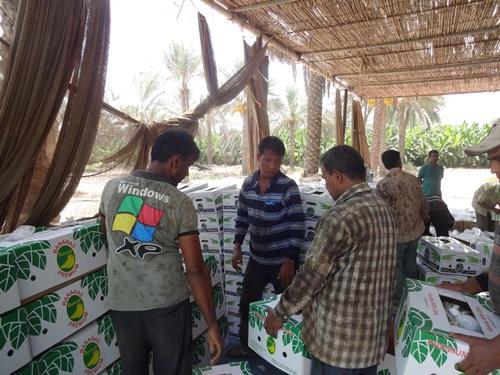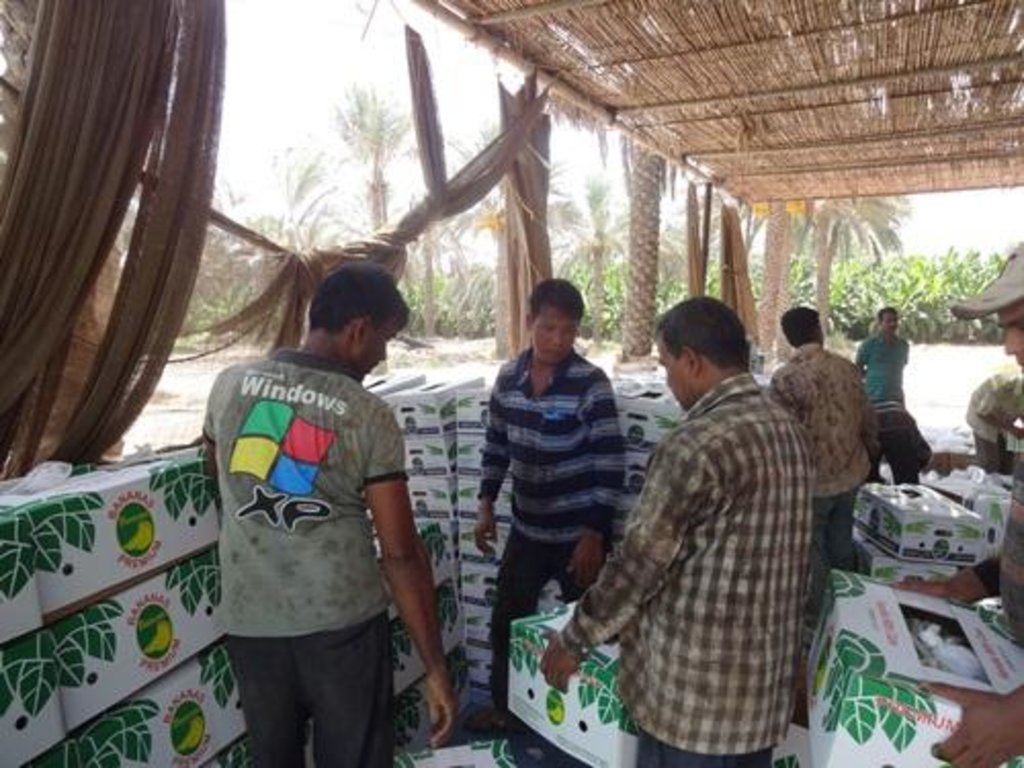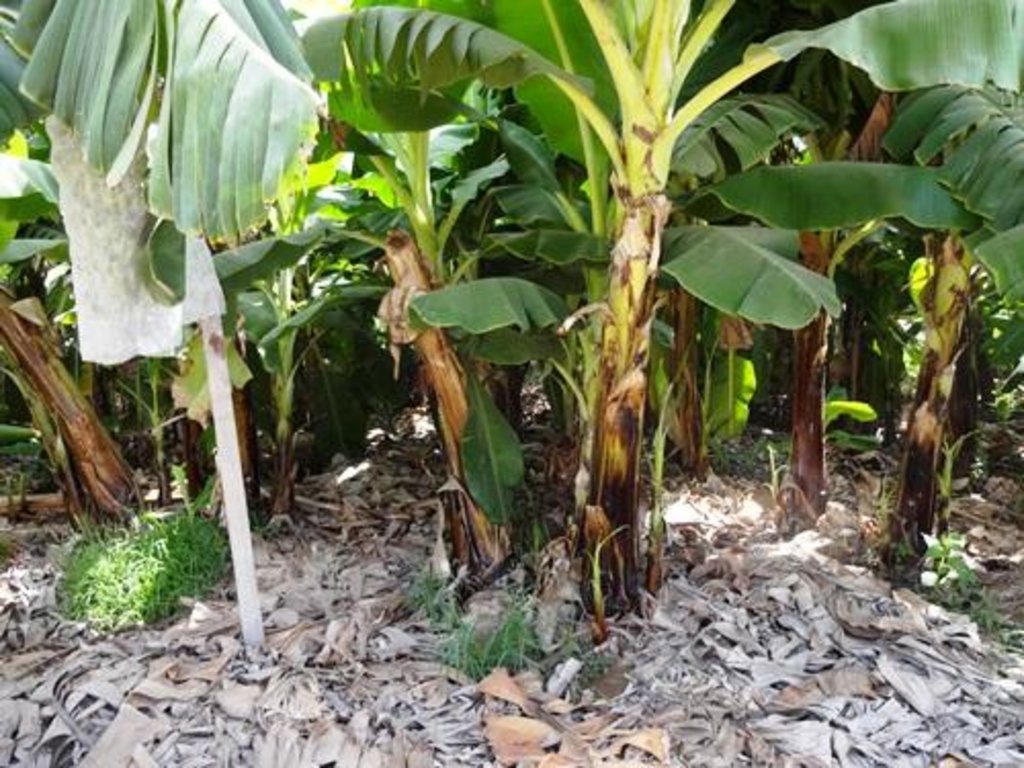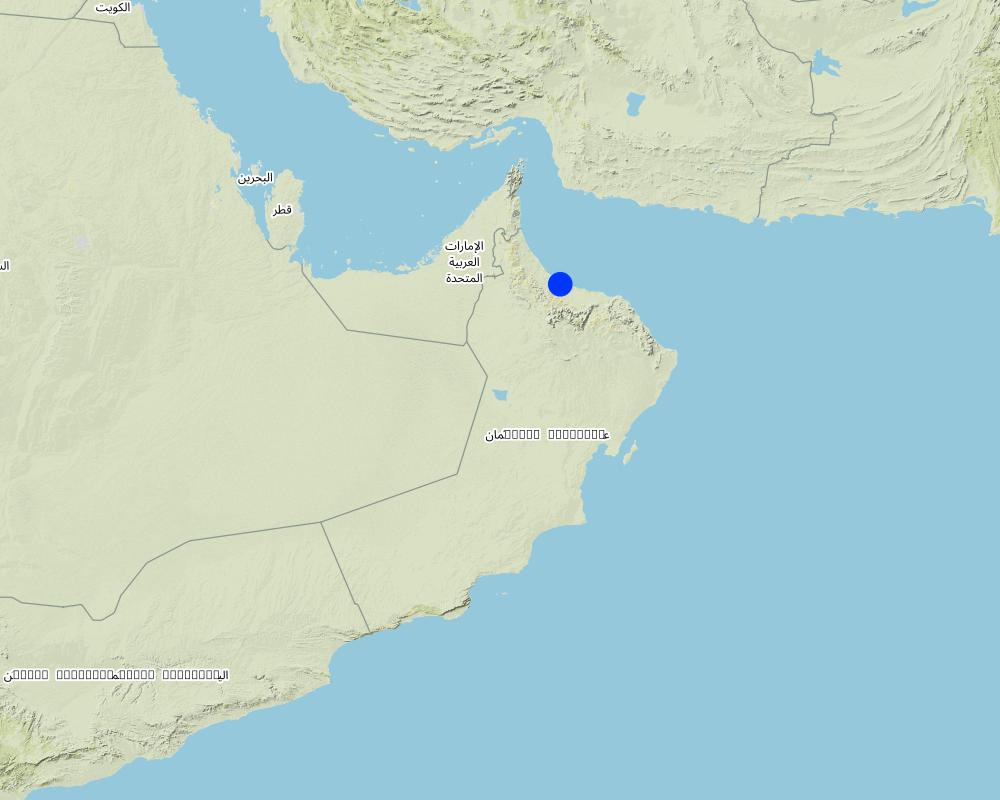Mulching and drip irrigation for banana [Oman]
- Creation:
- Update:
- Compiler: Daniel Danano Dale
- Editor: –
- Reviewers: Alexandra Gavilano, David Streiff, Joana Eichenberger
technologies_1143 - Oman
View sections
Expand all Collapse all1. General information
1.2 Contact details of resource persons and institutions involved in the assessment and documentation of the Technology
Name of the institution(s) which facilitated the documentation/ evaluation of the Technology (if relevant)
Food and Agriculture Organization of the United Nations (FAO) - Italy1.3 Conditions regarding the use of data documented through WOCAT
The compiler and key resource person(s) accept the conditions regarding the use of data documented through WOCAT:
Yes
2. Description of the SLM Technology
2.1 Short description of the Technology
Definition of the Technology:
Mulch and drip irrigated banana commercial farm.
2.2 Detailed description of the Technology
Description:
Banana is planted for commercial purposes on a medium sized farm in Elbatinah, Oman It is planted in a well prepared land, where ridges and furrows are made by machinery and manual labour. Seedlings are raised from tissue cultures that are imported. Before the seedlings are planted in the field the land is pulverized and watered. It is fertilized by combination of organic and inorganic fertilizers before seedlings are planted. After planting the seedlings get water through babblers from the pipes network. Water is delivered from a center, where soil nutrients are injected. Harvest takes place twice a year. Old banana plants are removed and chopped to be incorporated in the soils
The harvested banana is sold both in domestic market and mostly exported to neighboring countries. The most dominant variety cultivated is Cavendish. Hired labor coming from other countries are involved in most of the farm activities. Some are permanent workers, while most are temporary laborers who come and go depending on availability of seasonal jobs.
Purpose of the Technology: Managing land to control salinity of soils that impede normal growth and affect productivity of banana plants which produce banana for market.
Establishment / maintenance activities and inputs: The land is cleared first from weeds and dead plants using machinery. Mostly scrapers and cleaning machinery are used to remove dead banana plants and weeds. Following this the scraped material is incorporated into the soil or removed away. Then the land is harrowed and pulverized well before banana seedlings are planted. Tissue culture is imported from other countries and transplanted in plastic houses before planted out in the field. While planting the young seedlings are spaced at a given interval between plants and rows.
Natural / human environment: The farm is situated in one of the agricultural potential areas in the country. The land is nearly level to level. Some leveling is required wherever there is need to level. Land users in the surroundings include small holders, some with medium size farms and also there are large scale farms. The current farm where the documentation has been undertaken is among the top medium sized farms.
2.3 Photos of the Technology
2.5 Country/ region/ locations where the Technology has been applied and which are covered by this assessment
Country:
Oman
Region/ State/ Province:
Al Batinah
Further specification of location:
Almusina
Specify the spread of the Technology:
- evenly spread over an area
If the Technology is evenly spread over an area, specify area covered (in km2):
60.0
If precise area is not known, indicate approximate area covered:
- 10-100 km2
Comments:
Total area covered by the SLM Technology is 60 km2.
Map
×2.6 Date of implementation
If precise year is not known, indicate approximate date:
- less than 10 years ago (recently)
2.7 Introduction of the Technology
Specify how the Technology was introduced:
- through projects/ external interventions
3. Classification of the SLM Technology
3.1 Main purpose(s) of the Technology
- reduce, prevent, restore land degradation
3.2 Current land use type(s) where the Technology is applied

Cropland
- Annual cropping
- Perennial (non-woody) cropping
- Tree and shrub cropping
Perennial (non-woody) cropping - Specify crops:
- banana/plantain/abaca
Number of growing seasons per year:
- 2
Specify:
Longest growing period in days: 180; Second longest growing period in days: 180
Comments:
Major land use problems (compiler’s opinion): bacterial wilt diseases, shortage of water, fertility decline
Major land use problems (land users’ perception): diseases, shortage of water, fertility decline
Future (final) land use (after implementation of SLM Technology): Cropland: Cp: Perennial (non-woody) cropping
3.3 Has land use changed due to the implementation of the Technology?
Has land use changed due to the implementation of the Technology?
- Yes (Please fill out the questions below with regard to the land use before implementation of the Technology)

Other
3.4 Water supply
Water supply for the land on which the Technology is applied:
- full irrigation
3.5 SLM group to which the Technology belongs
- improved ground/ vegetation cover
- irrigation management (incl. water supply, drainage)
3.6 SLM measures comprising the Technology

agronomic measures
- A2: Organic matter/ soil fertility

vegetative measures
- V1: Tree and shrub cover
Comments:
Type of agronomic measures: better crop cover, early planting, manure / compost / residues, mineral (inorganic) fertilizers, soil conditioners (lime, gypsum), rotations / fallows, breaking compacted topsoil, furrows (drainage, irrigation), deep tillage / double digging
Type of vegetative measures: aligned: -contour, aligned: -linear, scattered / dispersed
3.7 Main types of land degradation addressed by the Technology

chemical soil deterioration
- Cs: salinization/ alkalinization
Comments:
Main causes of degradation: soil management, droughts, land tenure
Secondary causes of degradation: crop management (annual, perennial, tree/shrub), change in temperature, change of seasonal rainfall, population pressure, labour availability, inputs and infrastructure: (roads, markets, distribution of water points, other, …)
3.8 Prevention, reduction, or restoration of land degradation
Specify the goal of the Technology with regard to land degradation:
- reduce land degradation
Comments:
Secondary goals: prevention of land degradation, rehabilitation / reclamation of denuded land
4. Technical specifications, implementation activities, inputs, and costs
4.1 Technical drawing of the Technology
Technical specifications (related to technical drawing):
Technical knowledge required for field staff / advisors: high
Technical knowledge required for land users: moderate
Main technical functions: improvement of ground cover, increase in organic matter, increase / maintain water stored in soil
Secondary technical functions: improvement of surface structure (crusting, sealing)
Better crop cover
Material/ species: land mulch covered
Early planting
Material/ species: planting done in early october
Mixed cropping / intercropping
Material/ species: banana with mango
Manure / compost / residues
Material/ species: organic manure
Mineral (inorganic) fertilizers
Material/ species: Urea, NPK
Soil conditioners (lime, gypsum)
Material/ species: gypsum
Rotations / fallows
Material/ species: fallows
Aligned: -contour
Vegetative material: F : fruit trees / shrubs
Aligned: -linear
Vegetative material: G : grass
Scattered / dispersed
Vegetative material: C : perennial crops
Trees/ shrubs species: banana
Fruit trees / shrubs species: mango
Slope (which determines the spacing indicated above): 0-2%
If the original slope has changed as a result of the Technology, the slope today is (see figure below): 0-1%
4.2 General information regarding the calculation of inputs and costs
Specify currency used for cost calculations:
- USD
4.3 Establishment activities
| Activity | Timing (season) | |
|---|---|---|
| 1. | planting banana suckers | October-November |
| 2. | weeding and cultivation, mulching | November-February |
4.5 Maintenance/ recurrent activities
| Activity | Timing/ frequency | |
|---|---|---|
| 1. | irrigation | |
| 2. | mulching | |
| 3. | soil amendments / applying gypsum | |
| 4. | replanting banana suckers | |
| 5. | thinning and replanting | Nov-Jan |
4.6 Costs and inputs needed for maintenance/ recurrent activities (per year)
Comments:
Machinery/ tools: tractors, scarpers, pumps,
4.7 Most important factors affecting the costs
Describe the most determinate factors affecting the costs:
Soil and the residue to be removed from the ground during
5. Natural and human environment
5.1 Climate
Annual rainfall
- < 250 mm
- 251-500 mm
- 501-750 mm
- 751-1,000 mm
- 1,001-1,500 mm
- 1,501-2,000 mm
- 2,001-3,000 mm
- 3,001-4,000 mm
- > 4,000 mm
Agro-climatic zone
- arid
Thermal climate class: subtropics
5.2 Topography
Slopes on average:
- flat (0-2%)
- gentle (3-5%)
- moderate (6-10%)
- rolling (11-15%)
- hilly (16-30%)
- steep (31-60%)
- very steep (>60%)
Landforms:
- plateau/plains
- ridges
- mountain slopes
- hill slopes
- footslopes
- valley floors
Altitudinal zone:
- 0-100 m a.s.l.
- 101-500 m a.s.l.
- 501-1,000 m a.s.l.
- 1,001-1,500 m a.s.l.
- 1,501-2,000 m a.s.l.
- 2,001-2,500 m a.s.l.
- 2,501-3,000 m a.s.l.
- 3,001-4,000 m a.s.l.
- > 4,000 m a.s.l.
Comments and further specifications on topography:
Altitudinal zone: Coastal plains
Slopes on average: Nearly level to level slopes
5.3 Soils
Soil depth on average:
- very shallow (0-20 cm)
- shallow (21-50 cm)
- moderately deep (51-80 cm)
- deep (81-120 cm)
- very deep (> 120 cm)
Soil texture (topsoil):
- coarse/ light (sandy)
- medium (loamy, silty)
Topsoil organic matter:
- low (<1%)
If available, attach full soil description or specify the available information, e.g. soil type, soil PH/ acidity, Cation Exchange Capacity, nitrogen, salinity etc.
Soil fertility is very high
Soil drainage / infiltration is good
Soil water storage capacity is medium
5.4 Water availability and quality
Ground water table:
5-50 m
Availability of surface water:
poor/ none
Water quality (untreated):
for agricultural use only (irrigation)
5.5 Biodiversity
Species diversity:
- low
5.6 Characteristics of land users applying the Technology
Market orientation of production system:
- commercial/ market
Off-farm income:
- > 50% of all income
Relative level of wealth:
- average
- rich
Individuals or groups:
- cooperative
Level of mechanization:
- manual work
- mechanized/ motorized
Indicate other relevant characteristics of the land users:
Difference in the involvement of women and men: mostly men are farm laborers
Population density: 50-100 persons/km2
Annual population growth: 0.5% - 1%
30% of the land users are rich.
45% of the land users are average wealthy.
25% of the land users are poor.
5.7 Average area of land used by land users applying the Technology
- < 0.5 ha
- 0.5-1 ha
- 1-2 ha
- 2-5 ha
- 5-15 ha
- 15-50 ha
- 50-100 ha
- 100-500 ha
- 500-1,000 ha
- 1,000-10,000 ha
- > 10,000 ha
Is this considered small-, medium- or large-scale (referring to local context)?
- medium-scale
5.8 Land ownership, land use rights, and water use rights
Land ownership:
- company
- individual, not titled
Land use rights:
- individual
Water use rights:
- individual
5.9 Access to services and infrastructure
health:
- poor
- moderate
- good
education:
- poor
- moderate
- good
technical assistance:
- poor
- moderate
- good
6. Impacts and concluding statements
6.1 On-site impacts the Technology has shown
Socio-economic impacts
Production
crop production
Water availability and quality
demand for irrigation water
Income and costs
farm income
Socio-cultural impacts
food security/ self-sufficiency
SLM/ land degradation knowledge
livelihood and human well-being
Comments/ specify:
The farm is commercial and gets good return from the investment. Banana is at local market outlets and exported as well.The farm has skilled laborers to perform activities
Ecological impacts
Water cycle/ runoff
evaporation
Soil
nutrient cycling/ recharge
salinity
6.3 Exposure and sensitivity of the Technology to gradual climate change and climate-related extremes/ disasters (as perceived by land users)
Gradual climate change
Gradual climate change
| Season | increase or decrease | How does the Technology cope with it? | |
|---|---|---|---|
| annual temperature | increase | not well |
Climate-related extremes (disasters)
Meteorological disasters
| How does the Technology cope with it? | |
|---|---|
| local rainstorm | not well |
| local windstorm | not known |
Hydrological disasters
| How does the Technology cope with it? | |
|---|---|
| general (river) flood | not known |
6.4 Cost-benefit analysis
How do the benefits compare with the establishment costs (from land users’ perspective)?
Short-term returns:
positive
Long-term returns:
positive
How do the benefits compare with the maintenance/ recurrent costs (from land users' perspective)?
Short-term returns:
positive
Long-term returns:
positive
6.7 Strengths/ advantages/ opportunities of the Technology
| Strengths/ advantages/ opportunities in the compiler’s or other key resource person’s view |
|---|
|
use of modern techniques of soil salinity control such as use of gypsum How can they be sustained / enhanced? mixing of various salinity level water from wells and making it moderate to e distributed through central pumping network |
|
use of high yielding variety of bananna How can they be sustained / enhanced? start to develop own tissue culture |
|
seedling / saplings preparation from tissue culture How can they be sustained / enhanced? producing quality saplings for transplanting out in the field |
|
use of organic fertilizers in combination with inorganic fertilizers, soil moisture conservation techniques and management of soil nutrient recycling How can they be sustained / enhanced? monitor salinity level of organic fertilizers |
7. References and links
7.1 Methods/ sources of information
Links and modules
Expand all Collapse allLinks
No links
Modules
No modules





